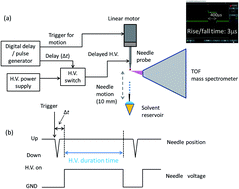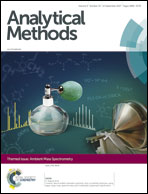Pulsed probe electrospray and nano-electrospray: the temporal profiles of ion formation from the Taylor cone†
Abstract
The temporal profiles of ion signals were measured for probe electrospray ionization (PESI) and nano-electrospray ionization (nESI) by changing the pulse width of the high voltage applied to the emitters (PESI: 0.12 mm o.d. and 700 nm tip diameter metal needle; nESI: metal-coated 15 μm i.d. silica capillary). The ion signals started to be detected at ∼400 μs and 5 ms, respectively, for PESI and nESI (solution: 10−5 M cytochrome c and 0.1–1% acetic acid in H2O/MeOH (1/1)). With the addition of 10 mM ammonium acetate in 10−5 M cytochrome c solution, the threshold for the signal appearance became about one order of magnitude longer with weaker signal intensities than those for acidic solutions. PESI was applied to real samples such as mayonnaise, natto (fermented soybeans), tomato ketchup and salmon eggs. Marked sequential electrospray was observed for these samples.

- This article is part of the themed collection: Ambient Mass Spectrometry


 Please wait while we load your content...
Please wait while we load your content...